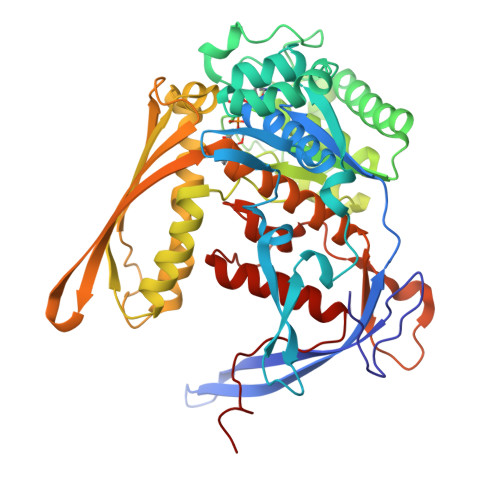Disorder-to-order active site capping regulates the rate-limiting step of the inositol pathway.
Trager, T.K., Kyrilis, F.L., Hamdi, F., Tuting, C., Alfes, M., Hofmann, T., Schmidt, C., Kastritis, P.L.(2024) Proc Natl Acad Sci U S A 121: e2400912121-e2400912121
- PubMed: 39145930
- DOI: https://doi.org/10.1073/pnas.2400912121
- Primary Citation of Related Structures:
9F2K - PubMed Abstract:
Myo-inositol-1-phosphate synthase (MIPS) catalyzes the NAD + -dependent isomerization of glucose-6-phosphate (G6P) into inositol-1-phosphate (IMP), controlling the rate-limiting step of the inositol pathway. Previous structural studies focused on the detailed molecular mechanism, neglecting large-scale conformational changes that drive the function of this 240 kDa homotetrameric complex. In this study, we identified the active, endogenous MIPS in cell extracts from the thermophilic fungus Thermochaetoides thermophila . By resolving the native structure at 2.48 Å (FSC = 0.143), we revealed a fully populated active site. Utilizing 3D variability analysis, we uncovered conformational states of MIPS, enabling us to directly visualize an order-to-disorder transition at its catalytic center. An acyclic intermediate of G6P occupied the active site in two out of the three conformational states, indicating a catalytic mechanism where electrostatic stabilization of high-energy intermediates plays a crucial role. Examination of all isomerases with known structures revealed similar fluctuations in secondary structure within their active sites. Based on these findings, we established a conformational selection model that governs substrate binding and eventually inositol availability. In particular, the ground state of MIPS demonstrates structural configurations regardless of substrate binding, a pattern observed across various isomerases. These findings contribute to the understanding of MIPS structure-based function, serving as a template for future studies targeting regulation and potential therapeutic applications.
Organizational Affiliation:
Faculty of Natural Sciences I, Institute of Biochemistry and Biotechnology, Martin Luther University Halle-Wittenberg, Halle/Saale 06120, Germany.



















